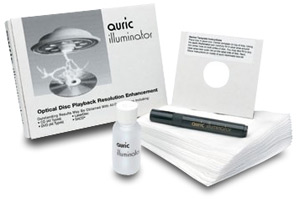 |
| September 1, 2005 Auric Illuminator Optical Disc Treatment Sic semper tyrannus!
In other words, fellow enthusiasts, my sneering days are behind me. In audio, to determine what has value, one sits back and listens. Nothing’s beyond the pale. If I’m sent dung beetles marinated in the bile of albino camels and sun-dried under the gaze of the Sphinx, I place the critters where directed, sit back, and listen. In the ringing words of my day-camp director, "Everyone into the pool!" One takes the plunge. Even in arranged marriages, love can blossom No sooner than it appeared was the compact disc heaped with scorn. Despite its swift acceptance elsewhere, up here in Audiophilia, listeners bitched, moaned, grumped, and groaned. Careers have been built on disparaging the medium. Of all the suggested ameliorations, marking a CD’s inner and outer edges with green ink struck pocket-protector types as further evidence of hobbyist idiocy, another solution in search of a problem. Perhaps. The turntable of a superb CD player, the Wadia 861se, is edged in a green band. The manufacturer makes no untoward fuss over its presence. It’s there, within, addressing whatever. The goods, are they good? The Auric Illuminator Optical Disc Treatment kit contains a permanent black-felt marker, a clear gel in a plastic applicator, 14 buffing pads, a disc-inking template, and instructions. So much for green. The marker-and-gel treatment is recommended for all optical discs except hybrid SACDs manufactured by Sonopress. The user is instructed to blacken the disc’s outer and inner rims. As a "very effective" option, one positions the template on a disc in its case and inks the clear hub as well as, in freehand, what’s left of the disc’s clear circumference. After applying the quick-drying ink, one buffs a few drops of the gel on both sides of the disc. And one is ready to hum along. Seeing double is sometimes recommended When a tweak you’re evaluating requires indelible marking, it’s best to have a duplicate on hand. Naxos in error sent me two copies of their release of Peter Maxwell Davies’ Naxos Quartets Nos. 1 and 2 [Naxos 8.557396], performed by the Maggini Quartet. A label commissioning the composition of string quartets puts a novel turn on a tradition dating back centuries to church, aristocracy, and haute bourgeoisie. (There are four Naxos Quartets.) The production is first rate. I gave one of the discs the ink-and-gel treatment, "very effective" option included, and left the other alone. To ensure as best I could that I wasn’t imagining what I heard, I went back and forth about two dozen times, playing one track, the second quartet’s Allegro. Time after time the treated disc’s strings sounded warmer and richer in texture. Early in the comparisons, I suspected that my imagination was running interference. "This really can’t be happening." But it was. I continued to compare that one track until I was reasonably certain that my ears were operating independent of expectation. Standing at the brink Years ago, a famously enthusiastic and likewise contentious audio nabob grabbed a CD I’d brought to his place and, before I could retrieve it, edged the thing with green ink. He’d a point to prove that I couldn’t hear, but that’s another story. It’s a rare disc, one of a set of music by a crazy Italian duke, Giacinto Scelsi, who contributed substantially to Europe’s avant-garde. Even today, I can’t help wincing at those scruffy green rings. I mention l’Affaire encre vert merely to observe that, one, the Auric Illuminator treatment is a whole lot more effective, and that, two, as a discophile, I value a recording’s as-issued appearance. On the one hand, the audiophile’s craving for better sound knows no impediment. On the other, art will out. The LP has it all over the CD in terms of sleeve-design opportunities. Conversely, the CD’s label side has proven a fertile field for graphics. I’m not convinced as I write these remarks that I’ll be blacking my collection’s transparent areas with opaque ink. If my reluctance strikes you as fussy, by all means, give the Auric Illuminator a shot. As I’ve proved to my own satisfaction, it works. Postscript Perhaps total opacity is something the folks who make optical discs need to look into. If blacking-out is as effective as my limited test suggests, it ought to occur as an aspect of manufacture. The gel’s application would remain the user’s responsibility. …Mike Silverton Auric Illuminator Optical Disc Treatment Audience, LLC E-mail: terry@audience-av.com
Ultra Audio is part of the SoundStage! Network. |
 "Ever thus to
tyrants!" Well, to one pipsqueak tyrant: me. I admit to a mindset I have since
repudiated, that of knee-jerk scoffer. Little over which audiophiles waxed ecstatic failed
to escape my derision. The notion, for example, that an aftermarket power cord could
improve a component’s performance was more than enough to provoke incontinence. Now I
buy the damned things. Your reporter’s conversion is one thing, oddities
another. Scammers still range the terrain, as do the sincerely deluded and, thank Euterpe,
those whose once-controversial practices and precepts few with ears now belittle.
"Ever thus to
tyrants!" Well, to one pipsqueak tyrant: me. I admit to a mindset I have since
repudiated, that of knee-jerk scoffer. Little over which audiophiles waxed ecstatic failed
to escape my derision. The notion, for example, that an aftermarket power cord could
improve a component’s performance was more than enough to provoke incontinence. Now I
buy the damned things. Your reporter’s conversion is one thing, oddities
another. Scammers still range the terrain, as do the sincerely deluded and, thank Euterpe,
those whose once-controversial practices and precepts few with ears now belittle.